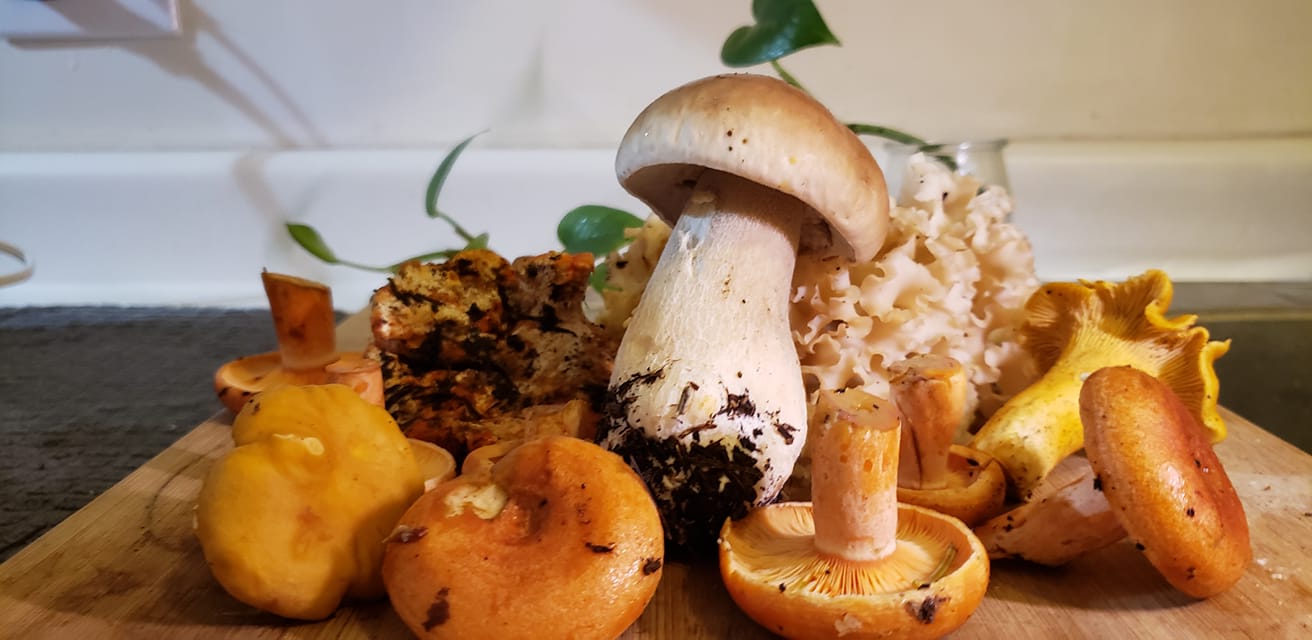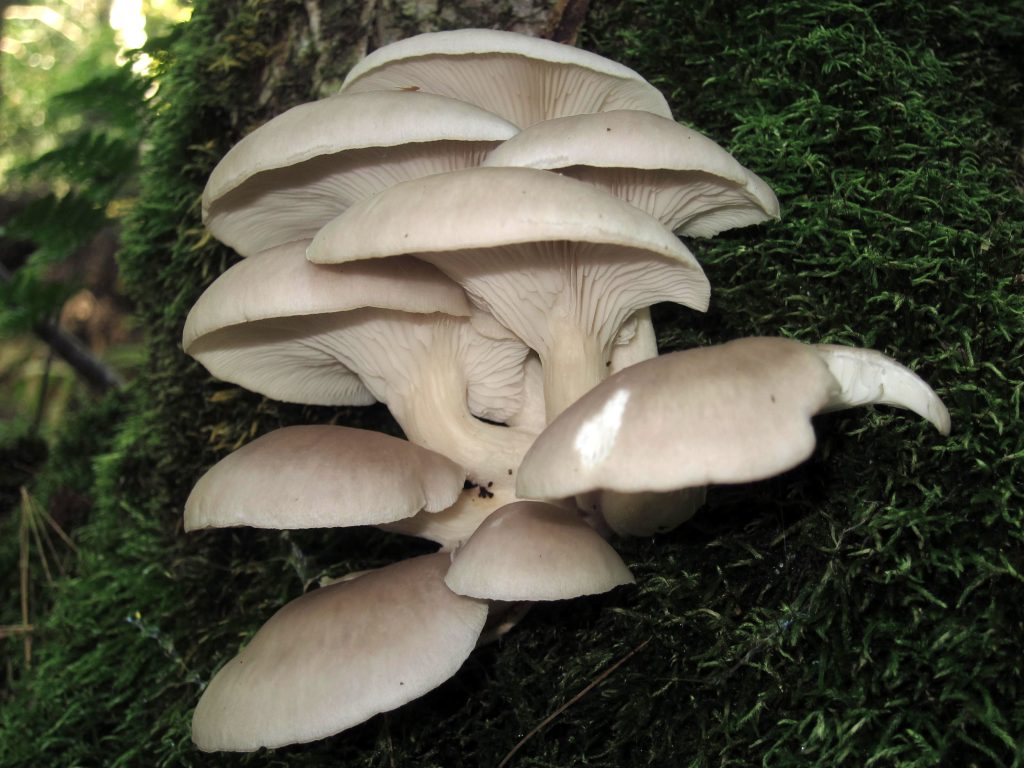When I decided to make mushroom picking a hobby, I couldn’t find a simple list of edible mushrooms specific to Vancouver Island, let alone Campbell River.
I had to look through tons of books, websites, and make a habit of getting out into the woods — finding mushrooms and bringing them home to identify.
After 20 years of research, I now know and pick over 36 different kinds of edible mushrooms in and around Campbell River! I’ve put together this list of some of the most common and easiest ones to find.
Warning: Eating the wrong mushroom can kill you. Have a good mushroom identification book, learn how to do spore prints, and ask someone knowledgeable if you are new.
And don’t eat any mushroom that you aren’t 100% sure of.
We have at least 3 deadly mushrooms in the area. They will kill you:
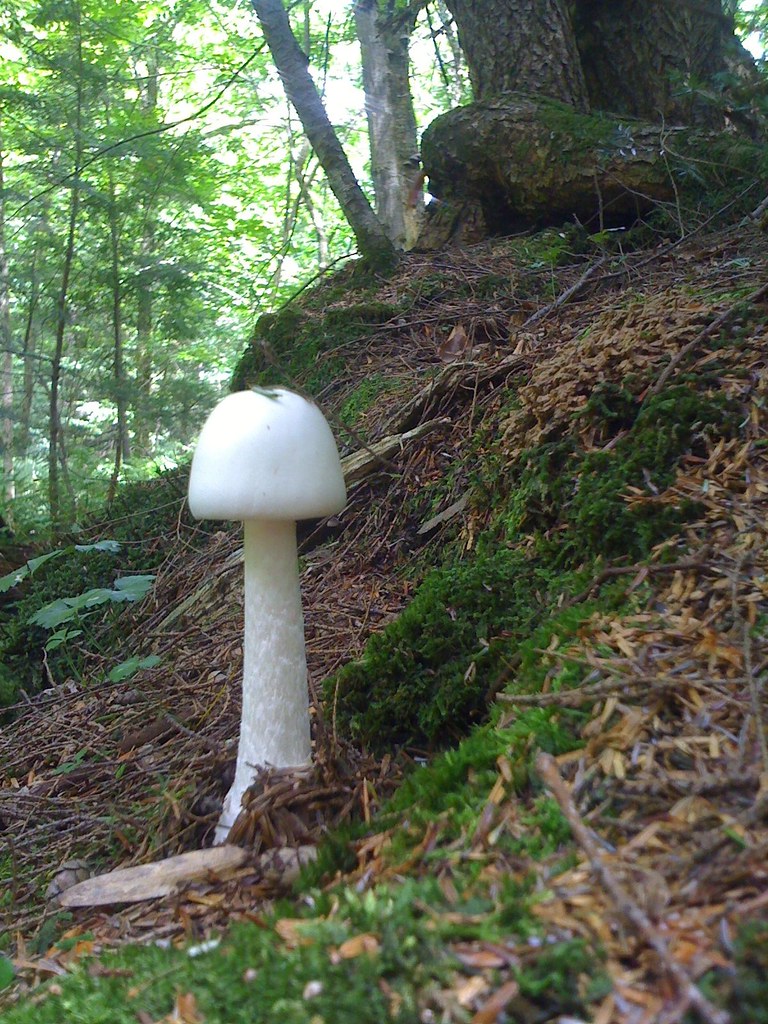
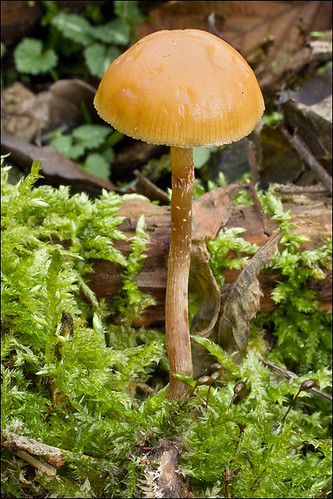

DO NOT EAT
Stay away from anything that looks like the above 3 mushrooms.
Additionally, there are plenty of other local toxic mushrooms that will make you very ill and can cause permanent kidney damage. Do not eat any mushroom that you can’t 100% positively identify.
Now, let’s take a look at some of the yummy mushrooms you can find in the forests near Campbell River.
Table of Contents
Golden Chanterelle
Cantharellus cibarius
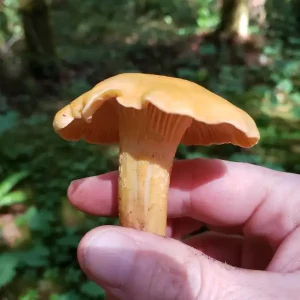
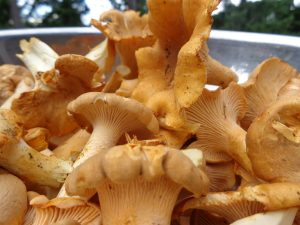
Golden Chanterelles are known for their golden color and distinctive vase-shaped appearance with ridges instead of gills underneath the cap.
They are typically found under coniferous trees like Douglas Fir or Western Hemlock in moist, old, forested areas. They have a unique and smooth, buttery, peppery flavor.
In Campbell River, you can find Chanterelles in many areas of Beaver Lodge Forest Lands and along the ERT. On good years, you’ll find them right along trails. Other close-to-town areas include Lost Lake and Snowden Demonstration Forest.
Learn more about Golden Chanterelle on Wikipedia
Chicken of the Woods
Laetiporus sulphureus
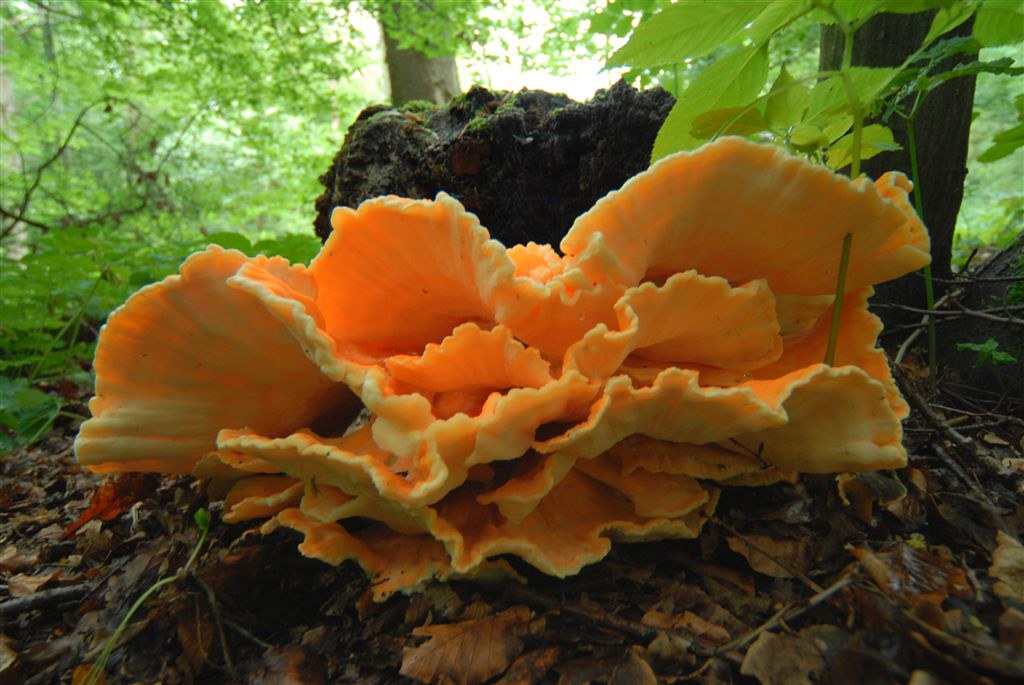
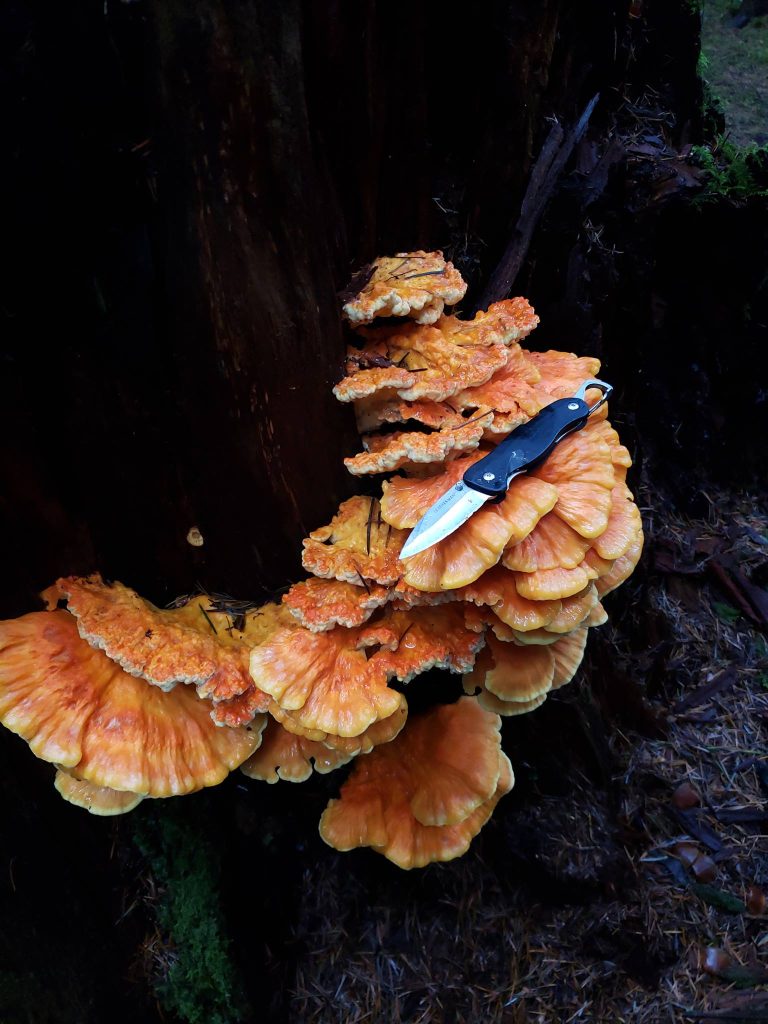
Chicken of the Woods is a bright orange and yellow shelf fungus that grows on dead or dying trees.
When young, it has a soft, chicken-like texture and a slightly tangy, lemony taste. As it ages it gets tougher and blander. However, just like chicken it tastes like whatever you season it with.
This mushroom is commonly found in late summer and fall on rotting stumps.
Learn more about Chicken of the Woods on Wikipedia
Sweet Tooth / Hedgehog Mushroom
Hydnum repandum
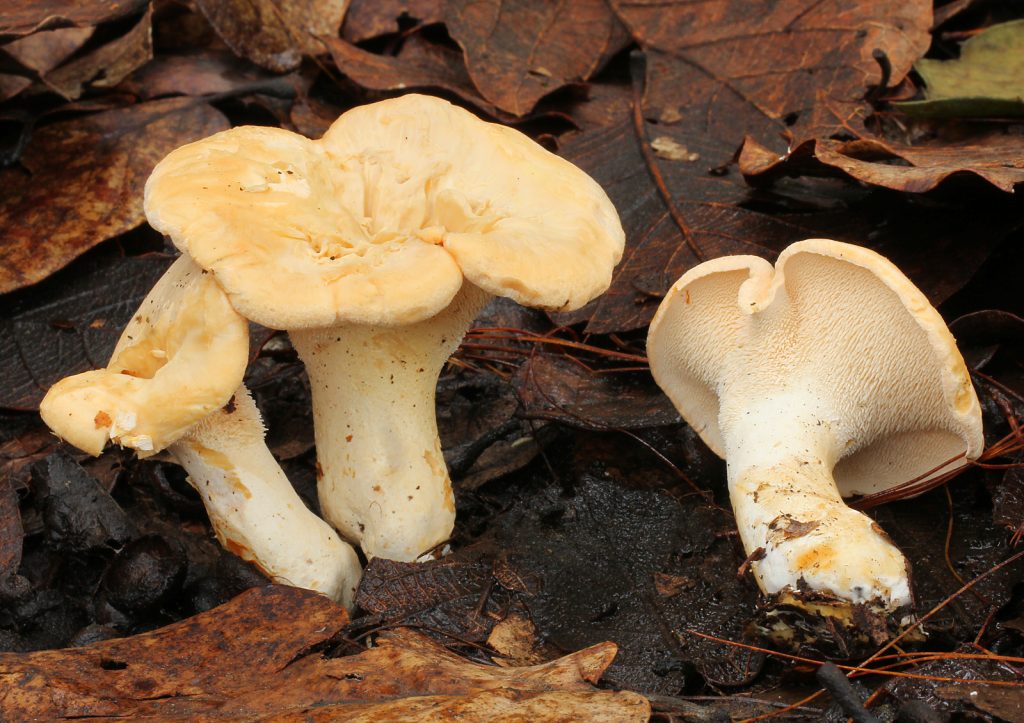
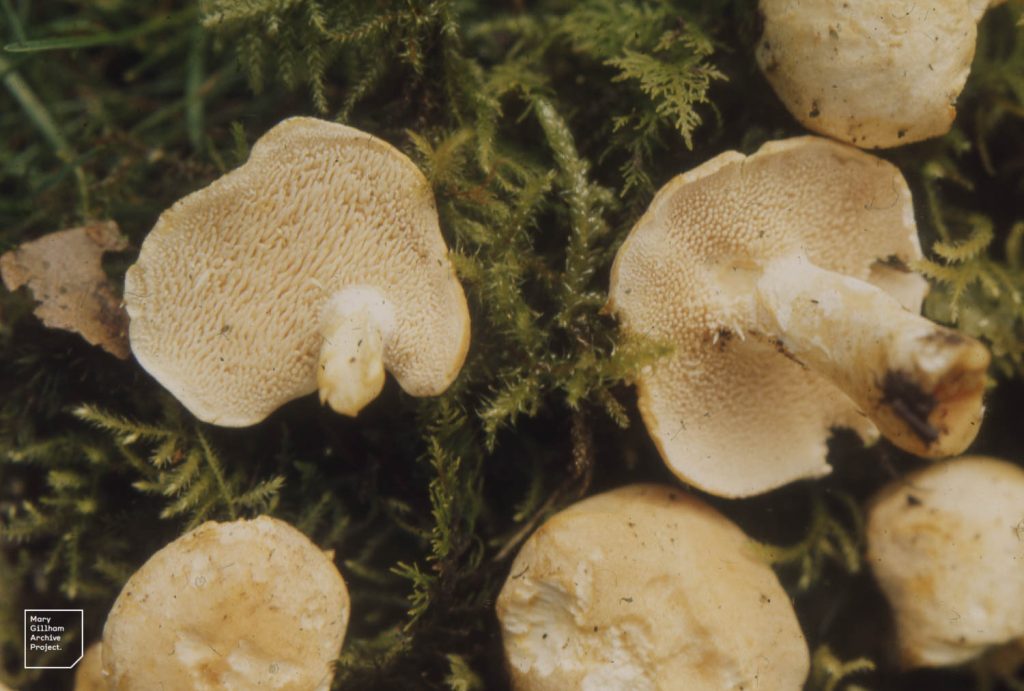
Sweet Tooth mushrooms, also known as Hedgehog mushrooms, are a light-colored mushroom (white, tan or sometimes almost peach color variations) have a slightly wavy or dimple-shaped cap, with tooth-like spines underneath instead of gills.
The teeth are the defining feature of hedgehog mushrooms.
They are usually found growing out of moss, near coniferous or deciduous trees in mixed forests. In the same areas you would be looking for chanterelles.
These mushrooms have a mild, nutty flavor. Cook them as you would chanterelles.
Learn more about Hedgehog Mushrooms on Wikipedia
Tip: Where there is one, there is some. If you find a mushroom, be sure to scout around carefully for more!
King Bolete (Porcini)
Boletus edulis
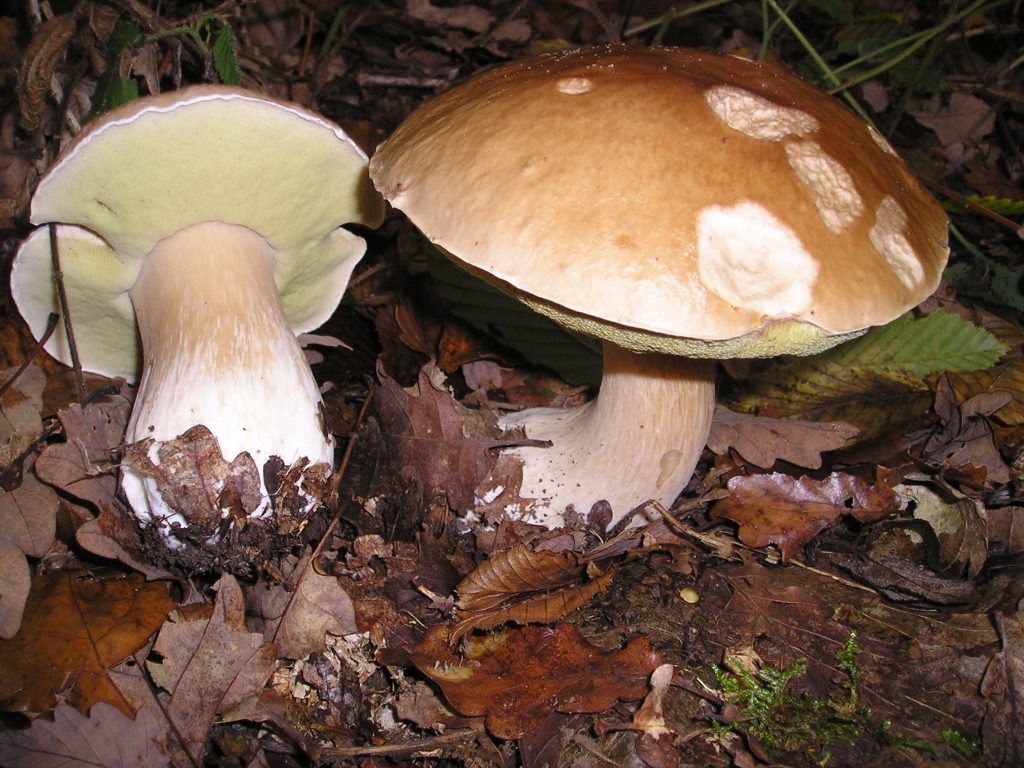
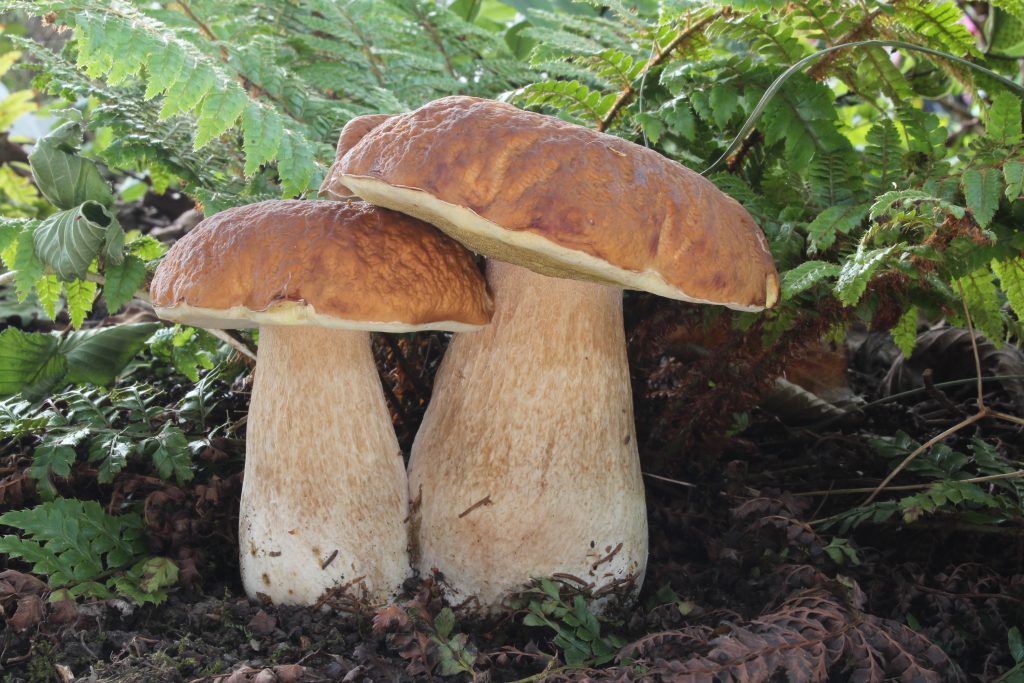
King Boletes are large, brown-capped mushrooms with a thick stalk and pores instead of gills underneath the cap. They are typically found under pine, fir, or spruce trees in the fall. King Boletes have a firm texture and a rich, nutty flavor.
I’ve found King Boletes in Beaver Lodge Lands, and also a few near Elk Falls. A friend said they pulled a few next to the Quinsam River…but I’ve never spotted them there.
Learn more about King Bolete on Wikipedia
Oyster Mushrooms
Pleurotus ostreatus
Oyster Mushrooms have a delicate, oyster-like appearance with white to light brown caps that grow in layered clusters on dead or dying hardwood trees.
Oyster Mushrooms have a mild flavor.
They can be found year-round (but generally spring and fall) in our temperate forests. When the temperature is about 10°C overnight for a few days, that’s when I’ll notice flushes of oysters.
Learn more about Oyster Mushrooms on Wikipedia
Lobster Mushroom
Hypomyces lactifluorum
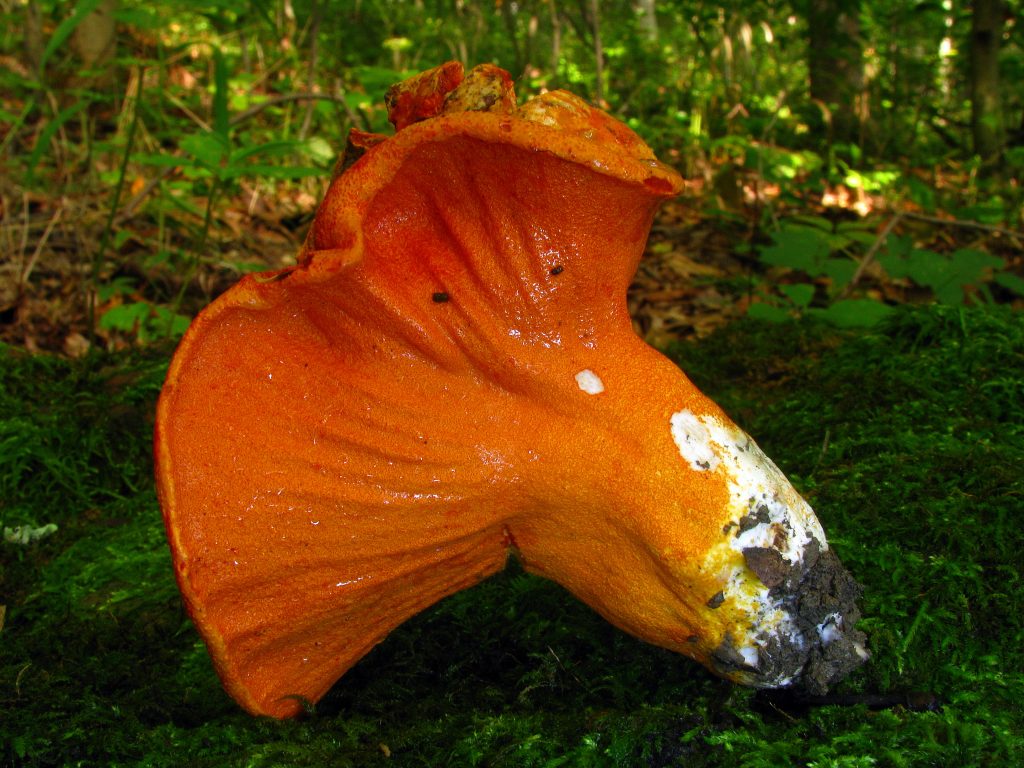
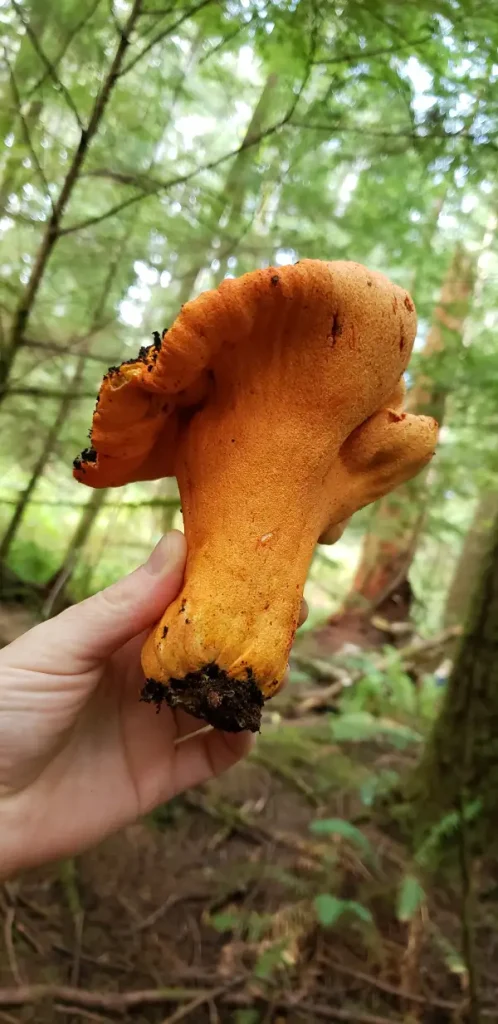
Lobster Mushrooms are actually a parasitic fungus that grows on certain mushroom species, giving them a lobster-like appearance with a bright red exterior and a firm, white interior.
They are typically found in our coniferous forests in late summer and fall. Lobster Mushrooms have a seafood-like flavor.
Lobsters grow in Beaver Lodge Lands, Snowden Forests, near John Hart Lake, Elk Falls, and just about any where you might find Chanterelles.
Learn more about Lobster Mushrooms on Wikipedia
Jelly Tooth
Pseudohydnum gelatinosum
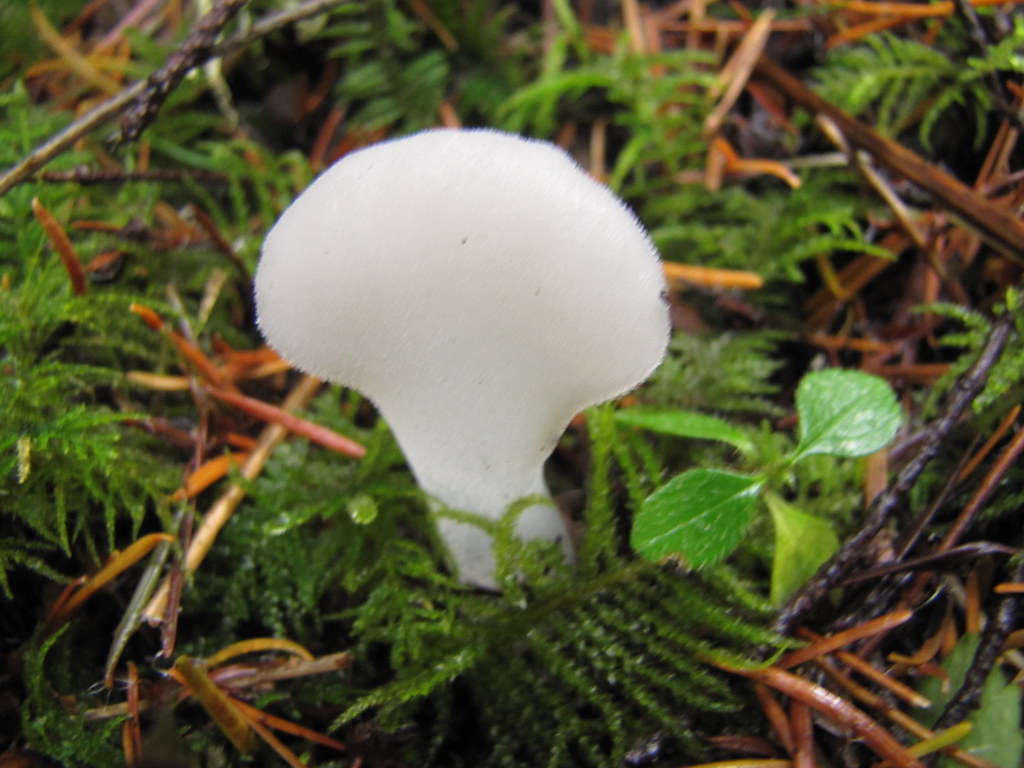

Jelly Tooth mushrooms have a gelatinous, translucent appearance with tooth-like spines underneath the cap. They are usually found on decaying conifer logs and stumps in moist areas.
Jelly Tooth mushrooms have a fun jello-like texture and a mild, earthy flavor. They are one of the few wild mushrooms I’ll eat raw.
Learn more about Jelly Tooth on Wikipedia
Winter Chanterelles (Yellowfoot)
Craterellus tubaeformis
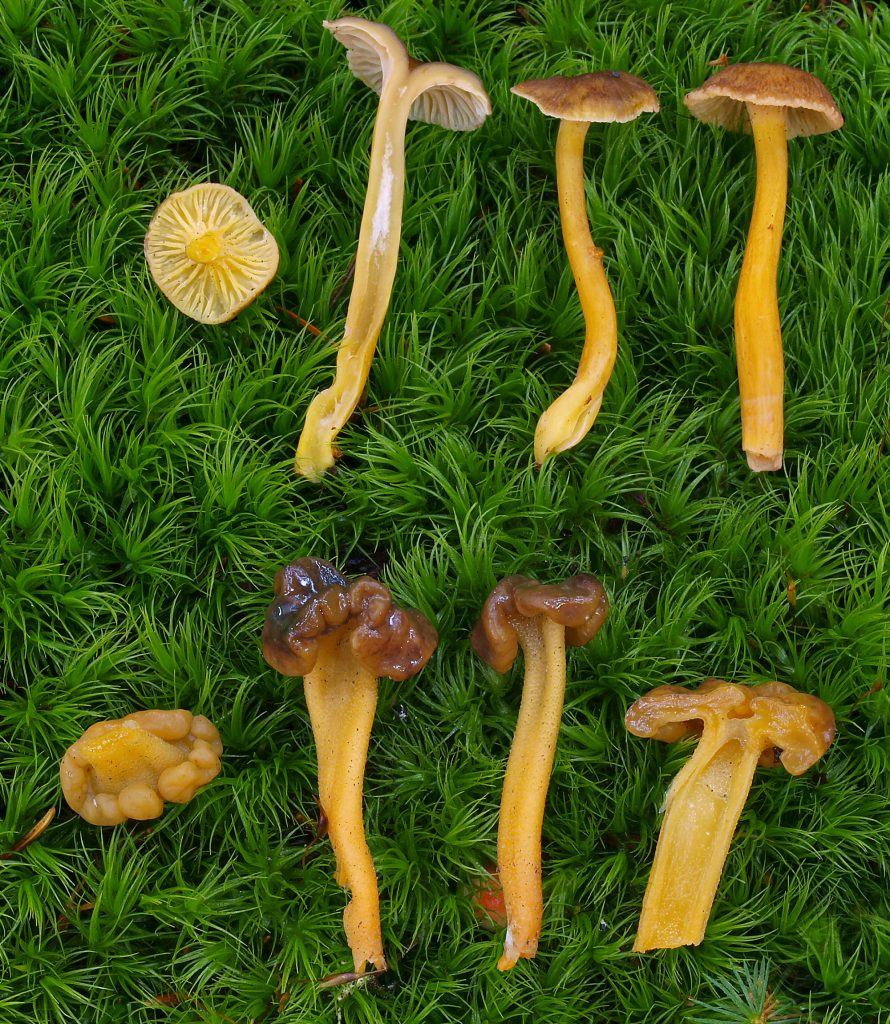
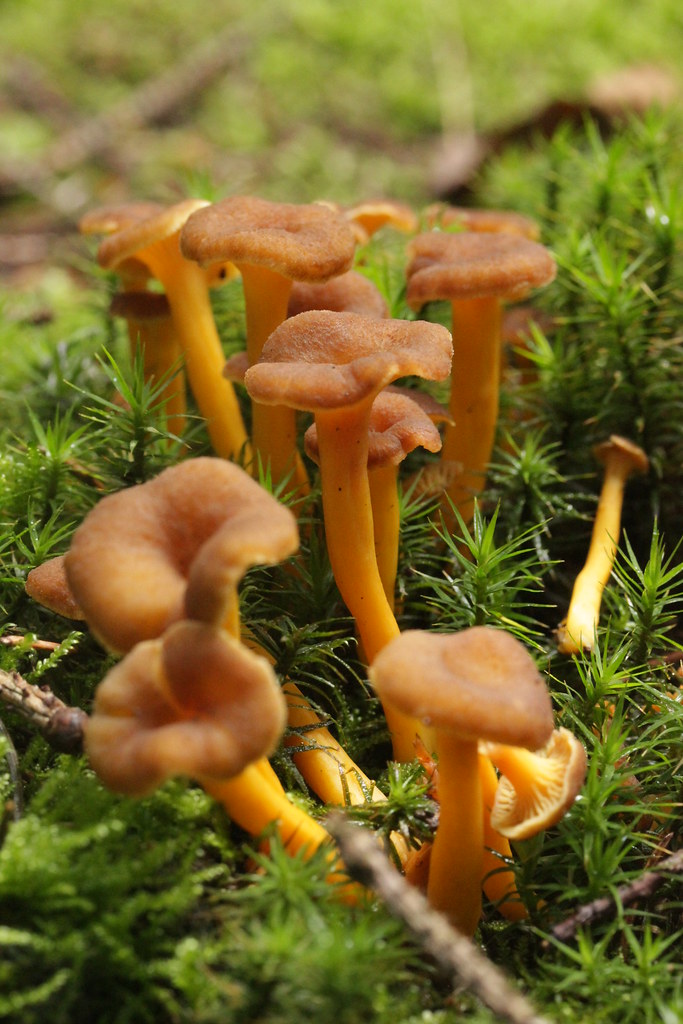
Winter Chanterelles are small delicate mushrooms with a trumpet-shaped cap, yellow to brown color, and a smooth surface. A key feature is that they have hollow stems that are yellow (or yellow-ish).
They are found in coniferous and mixed forests during the late fall and winter months. Most often, I find them in moss near stumps.
Winter Chanterelles have a delicate flavor similar to their golden counterparts. These are fantastic-tasting mushrooms that a lot of people overlook – great to cook with, use as you would chanterelles.
They are also one of my favorite dehydrated mushrooms, the flavor is more intense and the texture is nice re-hydrated into gravies. Yum.
Learn more about Winter Chanterelles on Wikipedia
Pine Mushrooms / Matsutake
Tricholoma magnivelare
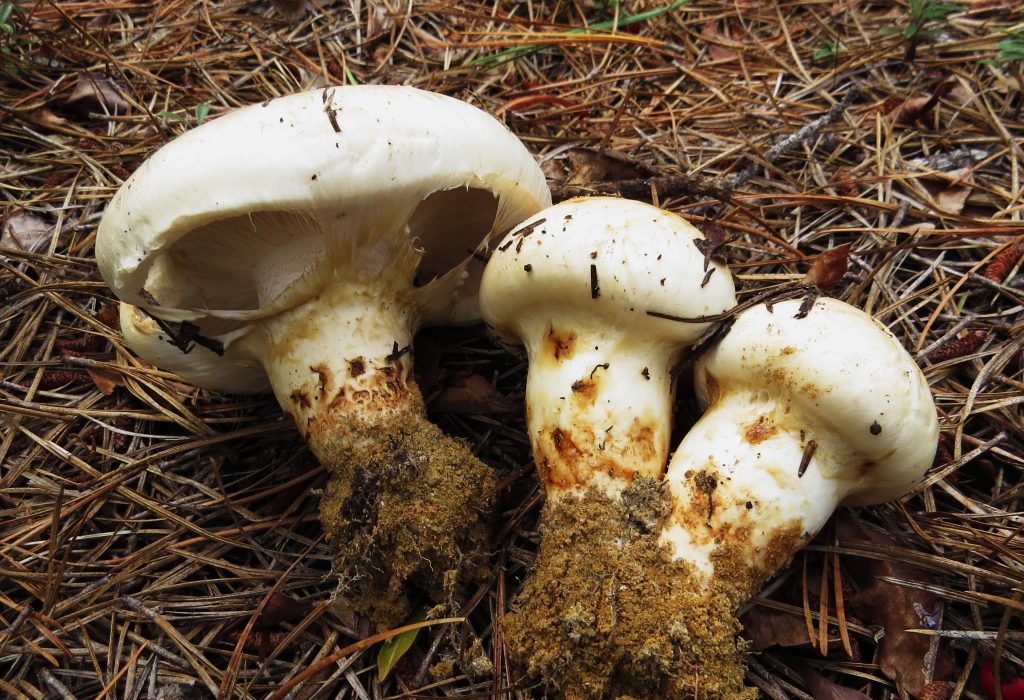
Pine Mushrooms, also known as Matsutake, are prized for their aromatic scent and unique flavor. They have a white cap (with a bit of tan / brown) with a thick, firm texture and are usually found under Douglas Fir and hemlock in the fall.
Last year was an incredible year for pine mushrooms; I found them everywhere. But generally, you want to look in established stands of Douglas Fir trees mixed with Hemlock. Mary Lake seems to be a popular area, closer to town try Snowden.
Update Oct. 22th: 2025 Pines are out, if you have spots, check ’em 🙂
Important: Some very toxic mushrooms can be confused with Pine mushrooms. DO NOT EAT a mushroom you think might be a Pine without getting a confirmed identification.
Learn more about Pine Mushrooms / Matsutake on Wikipedia
Delicious Milk Cap (Saffron Milk Cap)
Lactarius deliciosus
Delicious Milk Caps have a reddish-orange to brown cap with an milky or latex-like substance that oozes (or at least stains) orange when cut.
There are actually a few varieties of similar milk caps around Campbell River that are also edible. See: Lactarius rubrilacteus
In eastern Europe the caps are often enjoyed pickled. My favorite recipe is to fry them up with butter, onions and potatoes.
I’ve found them in many places around Campbell River, including Beaver Lodge Lands, near Elk Falls, Snowden and even in the paths by Miracle Beach.
Learn more about Delicious Milk Cap on Wikipedia
Cauliflower Mushroom
Sparassis crispa

Cauliflower mushrooms have a unique appearance resembling a creamy-white cauliflower head with ruffled edges. They are typically found at the base of conifer trees or stumps in the fall.
Cauliflower mushrooms have a mild flavor and a firm texture, making them a popular choice for cooking. The texture holds up well even after cooking, so some people use them as an alterative to egg noodles.
I’ve found these in Beaver Lodge Lands, Snowden, near Elk Falls, near the dump off Argonaut, and Stories Beach.
Learn more about Cauliflower Mushroom on Wikipedia
Rosy Spike Cap
Gomphidius subroseus

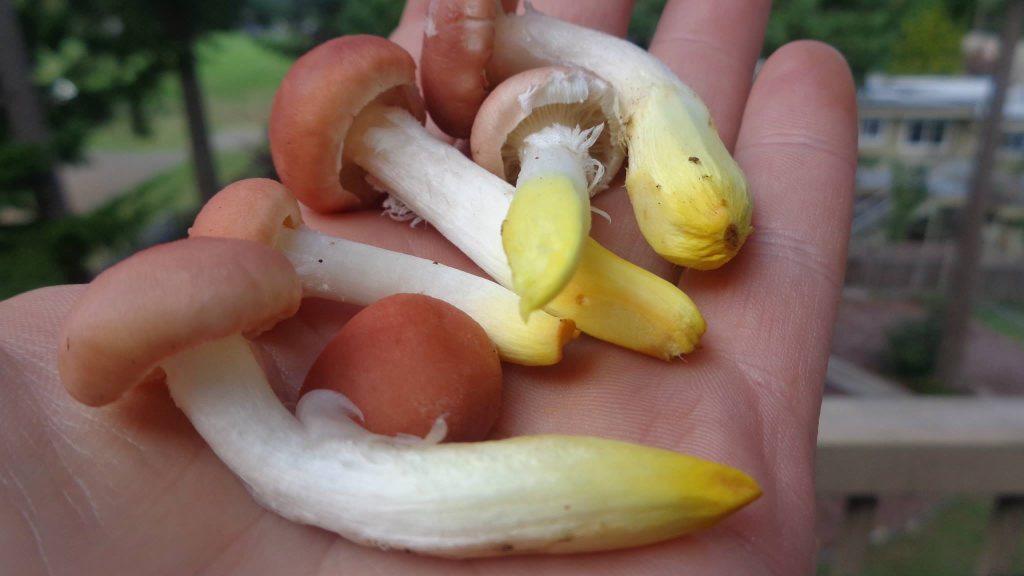
Rosy Spike Caps have a distinctive sticky rosy-pink to reddish-brown cap with with yellow near their base.
They are commonly found in coniferous forests, often near hemlock or Douglas fir trees, in late summer and fall. Most often, I find them along trails rather than in deep woods.
You must peel off the sticky coating before cooking and eating. The sticky part can cause stomach aches.
Learn more about Rosy Spike Cap on Wikipedia
Zeller’s Bolete
Xerocomellus zelleri
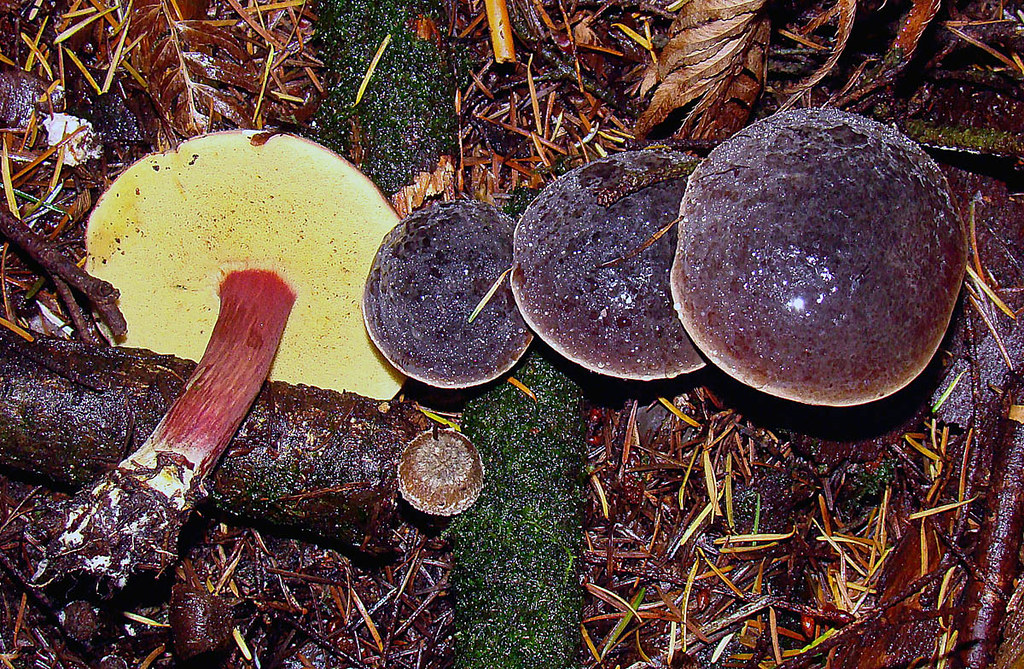
Zeller’s Bolete, scientifically known as Xerocomellus zelleri, is a species of bolete mushroom that is characterized by its dark cap and yellow pores underneath.
They are found in mixed forests, particularly under coniferous trees like pine and fir. They can be hard to spot, often blending in their surroundings at the base of Douglas fir trees.
Zeller’s Bolete take really well to dehydration to bring out their flavor. After dehydrating I blend in a coffee grinder and add to gravy mixes.
Learn more about Zeller’s Bolete on Wikipedia
Slippery Jack
Suillus luteus
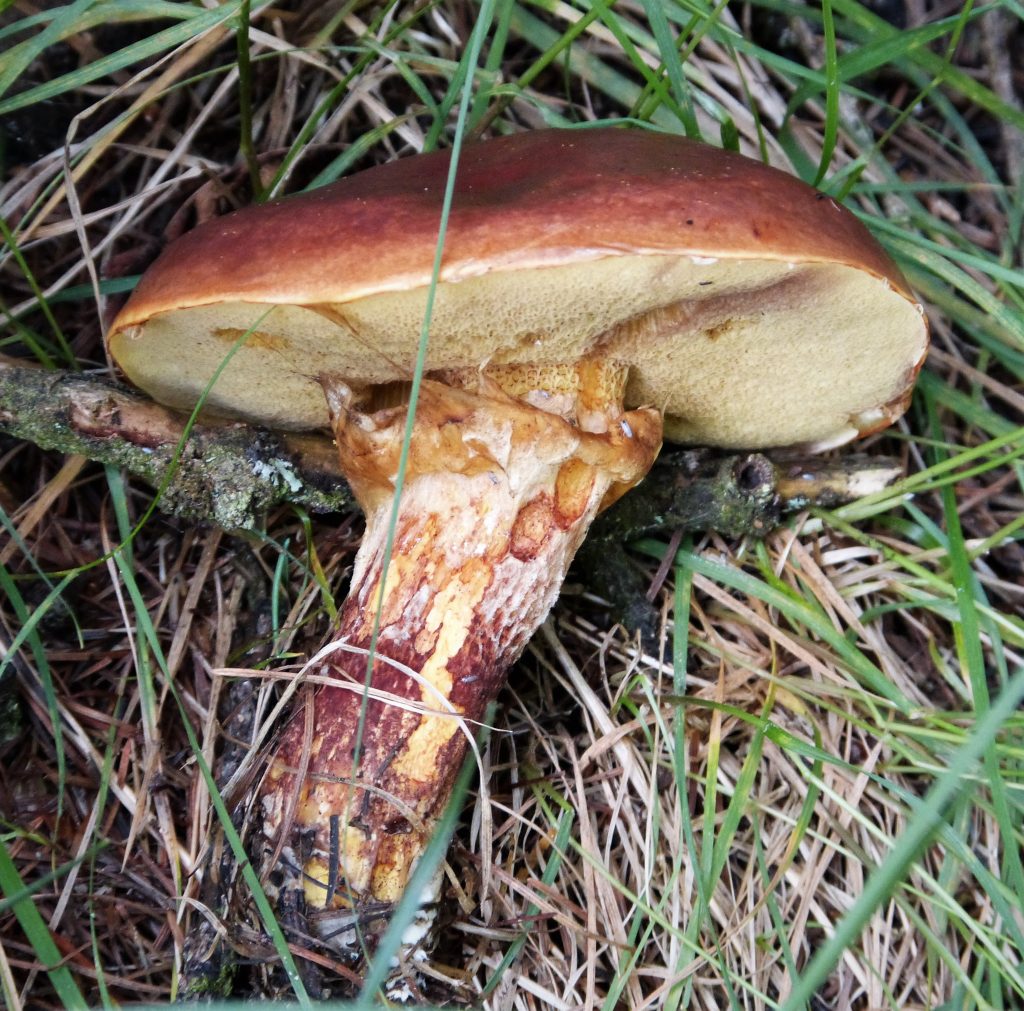

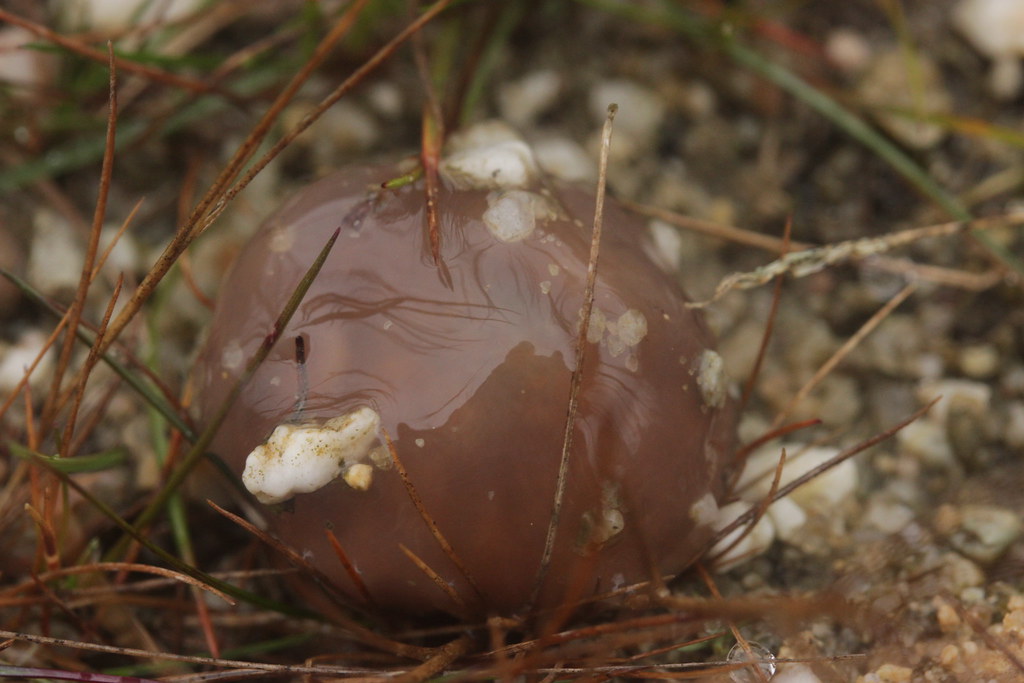
Slippery Jacks are characterized by their slimy or slippery texture on the cap and the stalk. They have a yellow to brown cap and a partial veil under the cap that leaves a ring on the stalk.
Please note that you need to peel off the slimy cap before cooking. I found this guide to processing and cooking slippery jacks that is very thorough!
Slippery Jacks are mycorrhizal with pine trees and are often found in pine forests, forming symbiotic relationships with the tree roots.
Learn more about Slippery Jack on Wikipedia
Remember: Eating the wrong mushroom can kill you. Make sure to have a good mushroom identification book, know how to use it, and don't eat any mushroom that you aren't 100% sure of.
Want to learn about mushrooms in Campbell River? I occasionally take folks out on mushroom foraging and identification walks. If you’d like to know the details — reach out.
